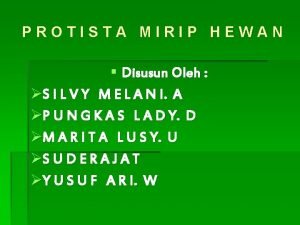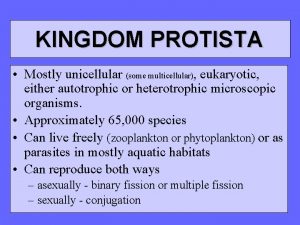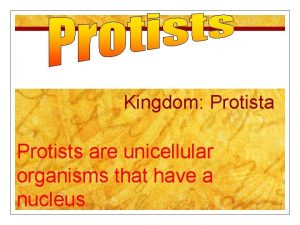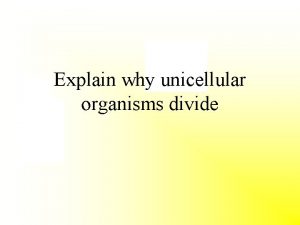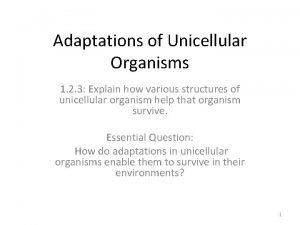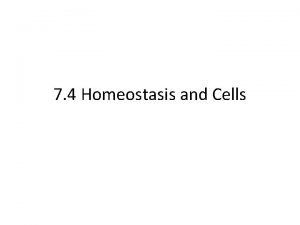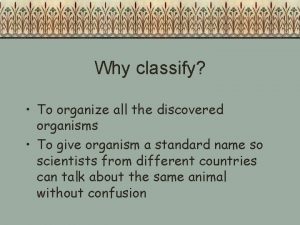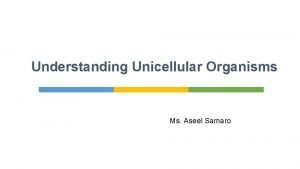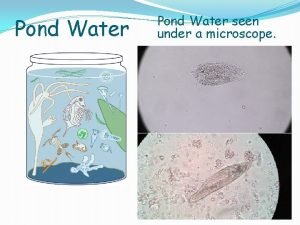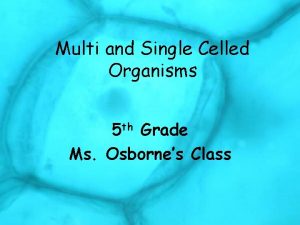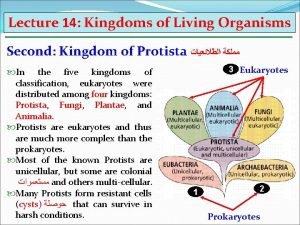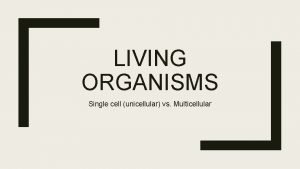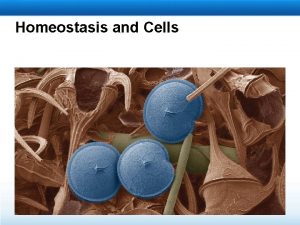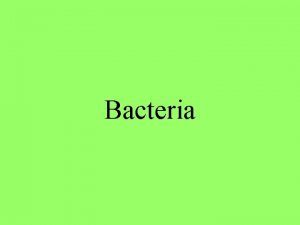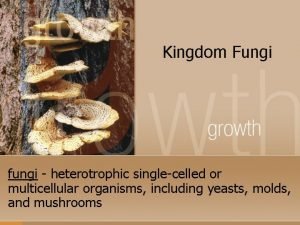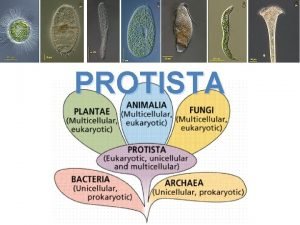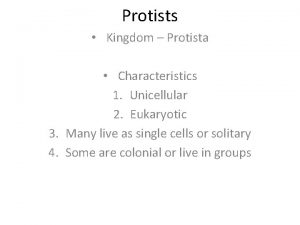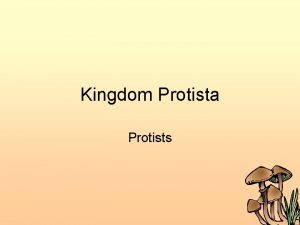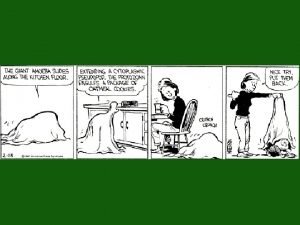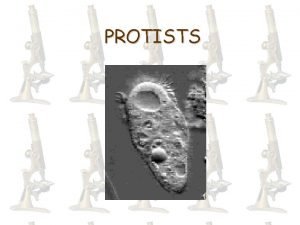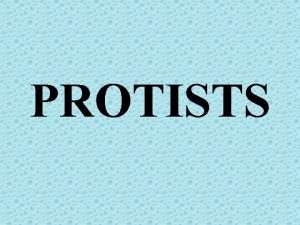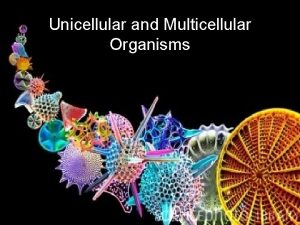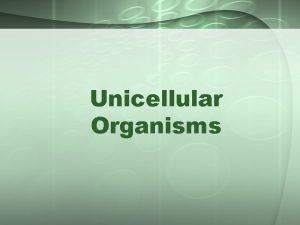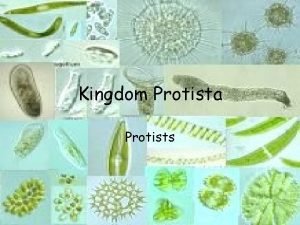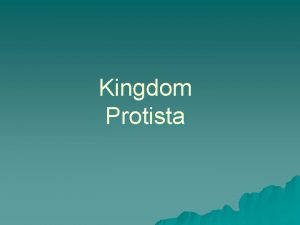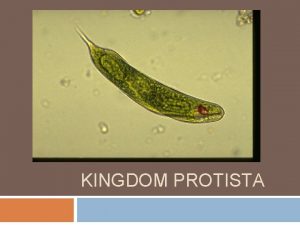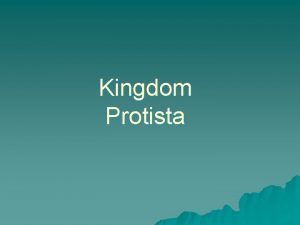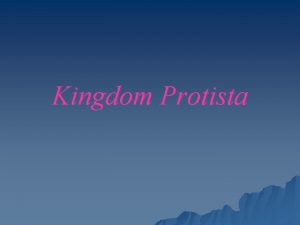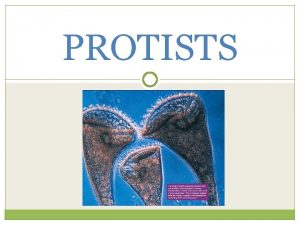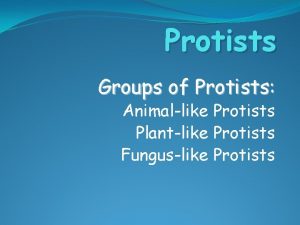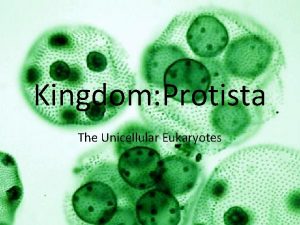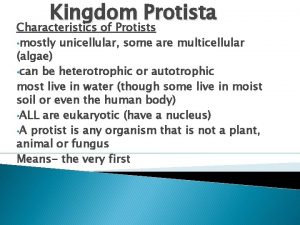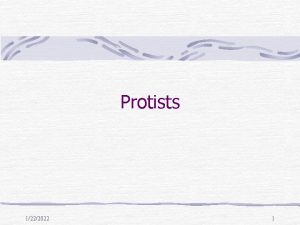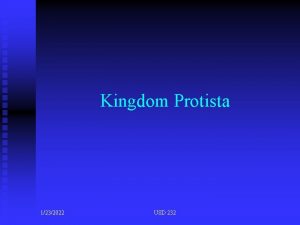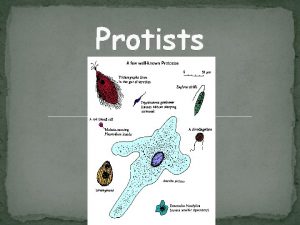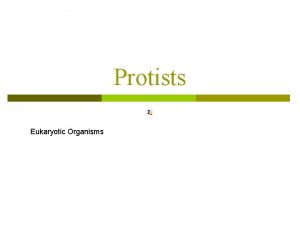Kingdom Protista Protists are unicellular organisms that have











































- Slides: 43

Kingdom: Protista Protists are unicellular organisms that have a nucleus.






Similar to Bacteria n Unicellular n One of the first groups of living things on Earth. (1. 5 billion years ago. ) n Microscopic n Can cause disease. n Can be parasites n Most reproduce asexually with binary fission

Difference from Bacteria n Has a nucleus. n Live in watery environment. n Generally n Protists live as individual cells. vary greatly in appearance and function.

3 Categories n I. Animal-like Protists. n II. Plant-like Protists. n III. Fungus-like Protists.

I. Animal-like Protists n Protozoan means “First Animal”. n Cells contain a nucleus. n Cells lack a cell wall. n They are heterotrophs. n Most can move on their own.

4 Groups of Animal-like Protists n 1. Sarcodines (SAHR-koh-dighnz) n 2. Ciliates (SIHL-ee-ihts) n 3. Flagellates (FLAJ- ehl-ihts) n 4. Sporozoans (spohr-oh-ZOHuhnz)

1. Sarcodines n Have pseudopods (Greek: “false foot”) n Extensions cytoplasm. of the cell membrane and n Pseudopods capture food. n Many are used for movement and to have shells. n These shells form limestone, marble and chalk.

One type: n Most familiar Sarcodine. n Pseudopods: n Blob shaped. n Contractile Vacuoles: controls amount of water inside n Food Vacuole: where food is digested.

Splitting n Amoebas reproduce by dividing into two new cells (binary fission). n Amoebas can respond to their environment. n They are sensitive to light and some chemicals.

2. Ciliates n Have cilia on the outside of their cells. n Tiny hair-like projections used for movement, to gather food and as feelers.

Type: Paramecium n Pellicle: n Oral groove: like the mouth n Gullet: n Food n Anal tough outer wall. holds food. Vacuole: digests food. Pore: removes wastes n 2 Contractile Vacuoles n 2 Nuclei n Reproduces by either binary fission or conjugation.

3. Flagellates (Zooflagellates) n Have a Flagellum: a long whip-like structure used for movement. n Many live in other animals

4. Sporozoans n All Sporozans are parasites. n They feed on cells and body fluids. n Form from Spores (tiny reproductive cells). n Pass from one host to another. from ticks, mosquitoes or other animals to humans.

II. Plant-like Protists (Algae) n Unicellular n Colonies n Can and Multicellular (groups of unicellular protists) move on their own n Autotrophs: make their own food from simple materials using light energy (photosynthesis). n 70% of the Earth’s oxygen is produced by Plant-like Protists! n Pigments: chemicals that produce color




6 Groups of Plant like Protists n Euglenoids (yoo-GLEE-noydz) n Diatoms (DIGH-ah-tahmz) n Dinoflagellates layts) n Red Algae n Green Algae n Brown Algae (digh-noh-FLAJ-eh-

1. Euglenoids n Green n Unicellular n Live in fresh water n Autotrophs, but can be heterotrophs under certain conditions. n Flagella n Eyespot: sensitive to light. n Chloroplasts n Pellicle


2. Diatoms n Unicellular n 10, 000 living species. n Aquatic n Glass like cell wall n Diatomaceous earth: course powder that comes from dead diatoms (toothpaste, car polish & reflective paint.


3. Dinoflagellates n Unicellular n Cell walls are like plates of armor. n Two flagella n Spins when it moves. n Colorful (pigments) n Can glow in the dark. n Causes Red Tide (sometimes bioluminescent)





Red Algae n Multicellular seaweeds n Live in deep ocean waters n Used for ice cream and hair conditioner n Used as food in Asia


Green Algae n Most are unicellular n Some n Few form colonies are multicellular n Can live in fresh and salt water and on land in damp places. n Very closely related to green plants.


Brown Algae n Commonly called seaweed n Can contain brown, green, yellow, orange and black pigments. n Attach to rocks n Have air bladders n Giant Kelp can be 100 meters long! n Used as food thickeners


III. Fungus-like Protists n Heterotrophs n Have cell walls. n Many have flagella and are able to move at some point in their lives. n Three types: Slime Molds, Water & Downy Molds n Reproduce with Spores (tiny cell that is able to grow into a new organism)

Water & Downy Molds n Live in water or moist places. n Tiny threads that look like fuzz. n Attack food crops n Caused the Irish Potato Famine.


Type: n Reproduce by Fruiting Bodies: n The Fruiting Bodies contain Spores. n At first they look like ameba, then later they look like mold. n Live on moist shady places. n Feed on bacteria and other microorganisms.

 Single celled and multi celled organisms
Single celled and multi celled organisms Insidan region jh
Insidan region jh Protist vs fungi
Protist vs fungi Kingdom protista multicellular unicellular
Kingdom protista multicellular unicellular Old kingdom middle kingdom new kingdom
Old kingdom middle kingdom new kingdom Nnn ruled
Nnn ruled Youtube
Youtube Capital of egypt during the old kingdom
Capital of egypt during the old kingdom Protists unicellular or multicellular
Protists unicellular or multicellular Protists are unicellular or multicellular
Protists are unicellular or multicellular Sporozans
Sporozans Images of multicellular organisms
Images of multicellular organisms Unicellular organisms means
Unicellular organisms means Why unicellular organisms divide
Why unicellular organisms divide Unicellular organisms
Unicellular organisms Carl linnaeus
Carl linnaeus How are unicellular and multicellular organisms alike
How are unicellular and multicellular organisms alike What do unicellular organisms do to maintain homeostasis
What do unicellular organisms do to maintain homeostasis Nematocyst
Nematocyst Unicellular marine organisms
Unicellular marine organisms Unicellular organisms
Unicellular organisms Unicellular fungi examples
Unicellular fungi examples Pond water under a microscope
Pond water under a microscope Single celled life form
Single celled life form Macronucleus
Macronucleus Is a nerve cell multicellular or unicellular
Is a nerve cell multicellular or unicellular Homeostasis in unicellular organisms
Homeostasis in unicellular organisms Unicellular prokaryotes kingdom
Unicellular prokaryotes kingdom Kingdom fungi unicellular or multicellular
Kingdom fungi unicellular or multicellular Is kingdom fungi unicellular or multicellular
Is kingdom fungi unicellular or multicellular What kingdom is photosynthetic aquatic and unicellular
What kingdom is photosynthetic aquatic and unicellular Competitive interaction
Competitive interaction Ngoại tâm thu thất chùm đôi
Ngoại tâm thu thất chùm đôi Block xoang nhĩ ecg
Block xoang nhĩ ecg Thể thơ truyền thống
Thể thơ truyền thống Thơ thất ngôn tứ tuyệt đường luật
Thơ thất ngôn tứ tuyệt đường luật Walmart thất bại ở nhật
Walmart thất bại ở nhật Tìm vết của mặt phẳng
Tìm vết của mặt phẳng Con hãy đưa tay khi thấy người vấp ngã
Con hãy đưa tay khi thấy người vấp ngã Tôn thất thuyết là ai
Tôn thất thuyết là ai Gây tê cơ vuông thắt lưng
Gây tê cơ vuông thắt lưng Sau thất bại ở hồ điển triệt
Sau thất bại ở hồ điển triệt Pyrophyta
Pyrophyta Protist is
Protist is



